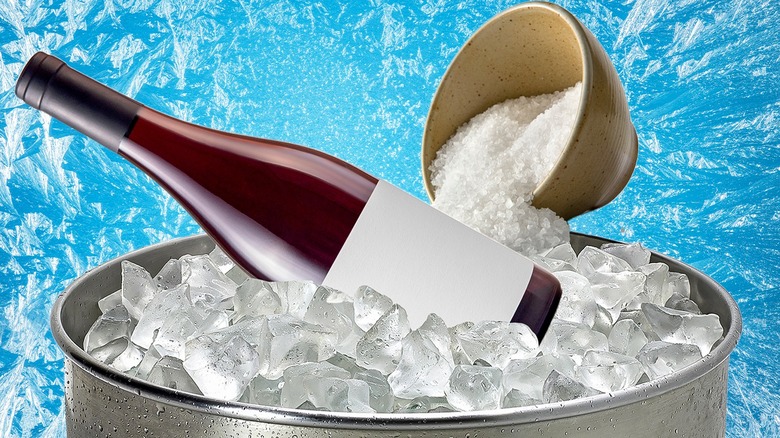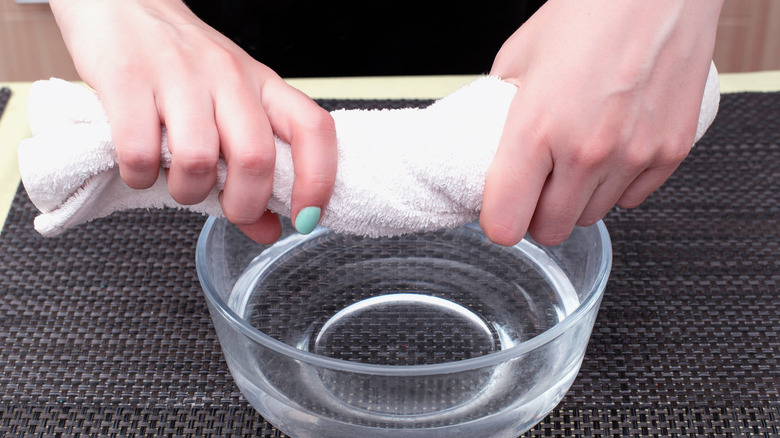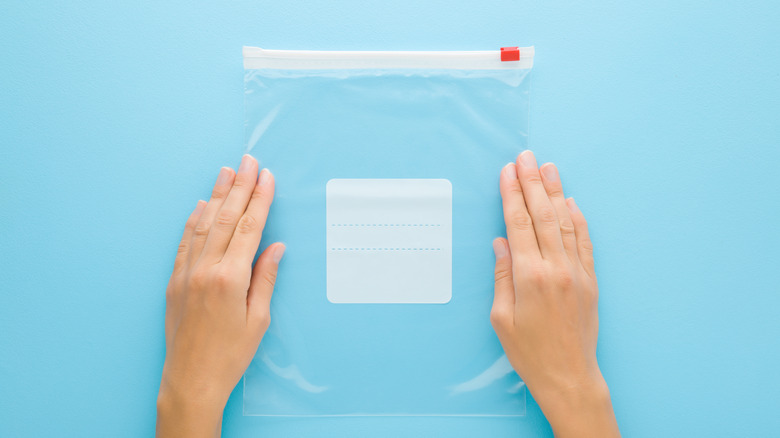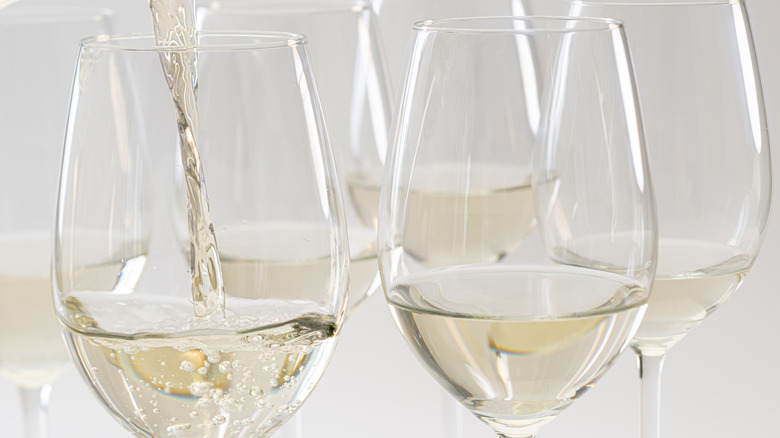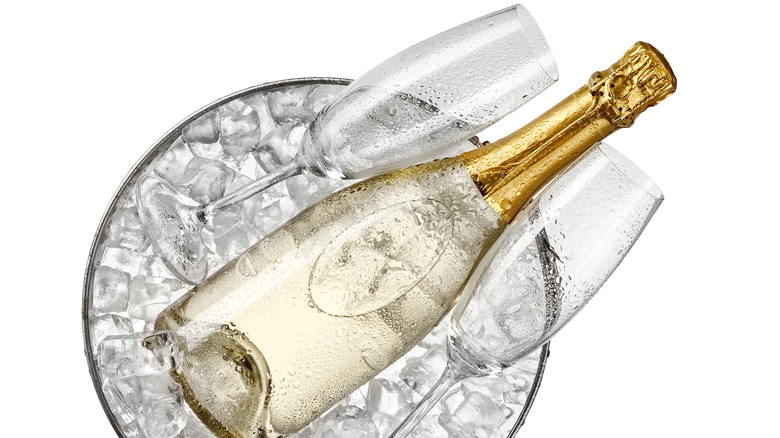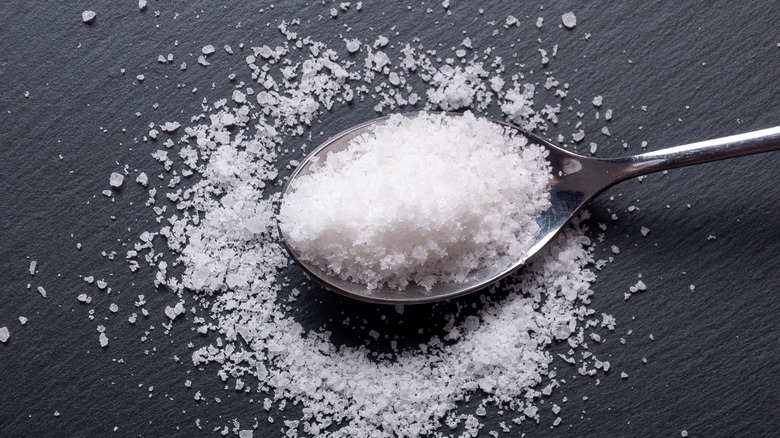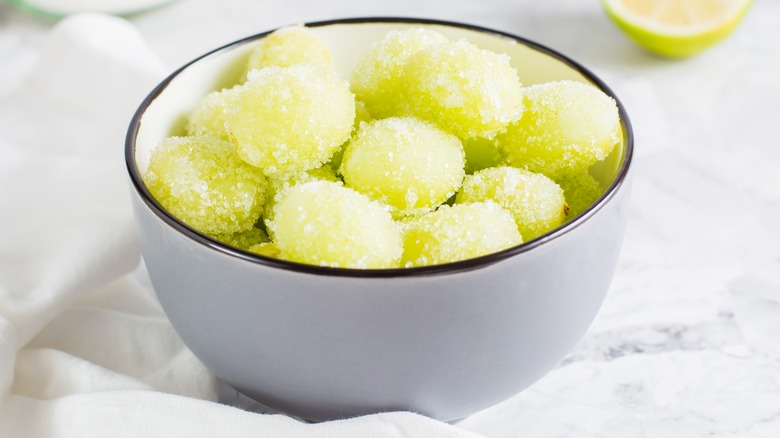6 Hacks You Need To Chill A Bottle Of Wine
Everyone from novices to aficionados knows the basic wine rule: White wine should be served chilled, and red wine at room temperature, right? Well, hang on! Not everyone has a perfectly calibrated wine fridge, and sometimes that bottle you planned to enjoy with dinner is still sitting on the counter. Worse yet, dinner's almost ready! Don't fret; we've scoured the internet for the best wine-chilling hacks and tested each one.
To kick things off, we placed a 750-milliliter bottle of white wine into our freezer (reading -10 F) to establish a control. It took 42 minutes to get the wine to a proper 45 F serving temperature. The experts at the Wine and Spirits Education Trust say sparkling and lighter whites should be served at around 45 F to 50 F, while fuller whites should be at 50 F to 55 F. For reds, lighter styles should be at 55 F, with bolder varieties coming in at 59 F to 64 F.
Once we had our initial time, we rolled up our sleeves and tested out these six common hacks we've found on the internet. To ensure our results were on point, we used bottles of the same wine for each experiment and checked our work with a reliable and calibrated thermometer. Remember, though, that your results might vary slightly depending on your freezer's quirks. Now let's find out which of these hacks is worth your time.
Freezer with a wet towel
We've encountered the towel trick all over the internet, with each source claiming varying degrees of success. The theory behind this hack is pretty straightforward: a wet towel will freeze faster than the wine bottle alone, creating a frosty layer that should, in theory, expedite the cooling process. We stumbled upon suggestions that both cloth dish towels and paper towels work best, so naturally, we decided to give both a shot.
For our test, we armed ourselves with paper towels and a trusty dish towel, then wrapped each around a wine bottle, and settled in for a chilly wait. Unfortunately, we ended up waiting longer than expected. Rather than speeding up the process, the towels seemed to create an insulating layer around the bottle, causing the wine to take even more time to get down to our ideal 45 F. The paper towel clocked in at 50 minutes, while the wet cloth dish towel kept us waiting for a frustrating 58 minutes.
After some further online sleuthing, it appears this method might perform better in a commercial freezer or a blast chiller, where cold air is consistently blown onto the bottle. For those of us with standard home freezers, alas, this hack turned out to be a bust.
Ziplock bag
In theory, this hack sounds promising. The method is simple: Pour the contents of your wine bottle into a Ziplock bag and then lay the bag down into the freezer. The rationale is that it increases the surface area of the wine in contact with the cold freezer shelf and the frigid air. Additionally, the plastic of the bag is thinner than the glass bottle, which could potentially lead to faster cooling.
Excited to give this one a go, we poured our wine into a freezer storage bag and laid it flat on our freezer shelf. Then we started our stopwatch, checking the temperature every 10 minutes. Lo and behold, this method did manage to cool our wine down to serving temperature a tad faster than just sticking the whole bottle in the freezer. Unfortunately, by a tad, we mean a mere 3-minute difference.
When we factor in the time and hassle it takes to transfer the wine to and from the bag (let's face it, pouring wine from a bag isn't exactly the epitome of elegance), we're not quite sure those 3 minutes are worth the hassle. On the flip side, if those chilled wine bags are doing double duty and acting as ice packs for your cooler, then we're all in!
Pour, then chill
Picture this: You've just wrapped up a long day at work, and you're yearning for a single glass of wine — this hack might just be your saving grace. The essence of this method comes from a simple premise that smaller quantities of liquid cool down more rapidly than larger ones. By this logic, if you portion your wine before placing it in the freezer, you could reasonably expect a faster cooling time. Plus, as an added bonus, when you take it out, your wine is already perfectly chilled and ready to be sipped from a frosty glass.
To put this one to the test, we poured a 5-ounce glass of wine, placed the whole thing in the freezer, and started our timer. It was around this point that we began pondering the assortment of items that sometimes reside in our freezer, some of which don't exactly have the most pleasant of aromas (we're looking at you, fish stock). So, with that in mind, we decided to go a step further and pour another glass, this time covering the mouth of the glass with plastic wrap.
The outcome? A mere 20 minutes of chilling time for the uncovered glass and 22 minutes for the covered one. While this certainly isn't as quick as some of the other hacks we'll get to, it's still twice as fast as cooling the entire bottle.
Bucket of ice and water
Now we come to one of the classic wine-chilling hacks beloved by waiters, bartenders, sommeliers, and even the Barefoot Contessa Ina Garten. It's also one that makes perfect sense, for, in the immortal words of Andre 3000 from Outkast, "What's cooler than being cool?" The answer is, of course, "Ice cold!" All right, all right, all right.
Now, the only thing cooling down our enthusiasm is that, due to its shape, ice has difficulty making full contact with your wine bottle. That's where the addition of water comes in, helping to create a frigid bath that envelops your bottle and rapidly cools it down. We came in with a good feeling about this one. Following the method we found on Ms. Garten's Instagram, we filled a metal bucket halfway with ice (approximately 3 pounds in our case), placed our wine bottle in, and added water until it reached the neck of the bottle.
Our trusty thermometer confirmed that the icy water bath measured an impressively chilly 34 F when we started the clock. What's even more impressive, this method had our wine down to the perfect serving temperature in a surprisingly brisk 8 minutes. We're happy to say our suspicions were confirmed. This is a fantastic hack, as long as you have a solid supply of ice at your disposal.
Add some salt
We're not gonna lie, this hack might make your head spin a little if you don't have a degree in science. According to Science Notes, the introduction of salt into ice water lowers the temperature at which water freezes, causing ice to melt instead of harden. Got it? It's the same reason salting roads and sidewalks helps prevent them from icing over. By reducing the freezing point, you end up with colder water and less ice.
We embraced our inner high school science geeks for this hack, and we're happy to say the experiment worked like a charm. Adding a half cup of kosher salt to our ice bath managed to lower the temperature to a frosty 29 F, a full 3 degrees below the freezing point of regular water. Even better, our wine bottle was beautifully chilled and ready to serve in a mere 6 minutes. This hack is another winner, although it does come with the small caveat of requiring a good amount of extra salt to pull off.
When it comes to both the ice water and salt hacks, we found that agitating the mixture can significantly cut down your chilling time, often by almost half! Whether you're using a serving spoon, an immersion blender, or just giving that wine bottle a good spin, you'll find yourself enjoying delightfully cold wine in as little as 3 to 4 minutes.
Frozen grapes
While you should think twice about putting ice in your wine, the instinct isn't entirely off; it's just the method that needs some fine-tuning. We need something that will cool our wine down without diluting it. This is where the frozen grape hack comes in. Ideally, these perfect little packages will get our wine to the perfect temp without compromising the flavor or mouthfeel.
Our results for this hack ended up being our biggest surprise by far. To put it to the test, we added six frozen jumbo grapes to a glass of wine poured at room temperature (75 F in our case). We were blown away by the results. The temperature dropped below 45 F in a mere 3 minutes and remained refreshingly cold for over 10 minutes afterward getting watered down.
With our curiosity piqued, we wondered what this trick could do for an already chilled glass. It turned out to be just as impressive. The grapes managed to lower the temperature in our wine glass by a whopping 10 degrees in under a minute and held it at or below our desired 45 F serving temperature for an astounding 20 minutes. This is a fantastic trick for a scorching day and an excellent reason to keep a stash of frozen grapes on hand.
